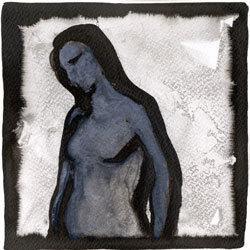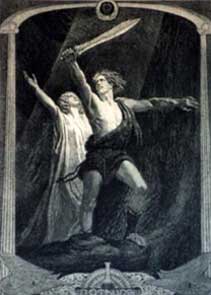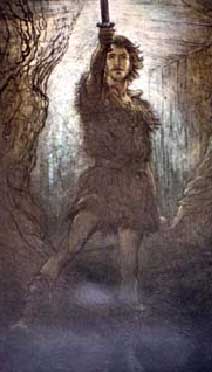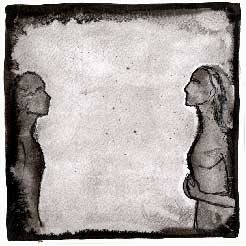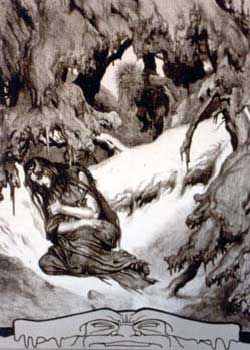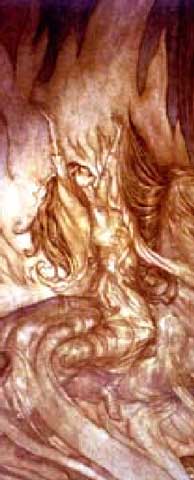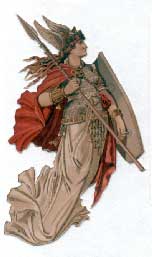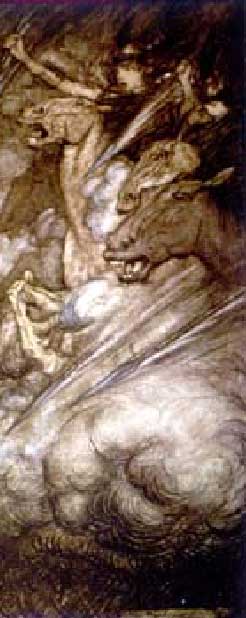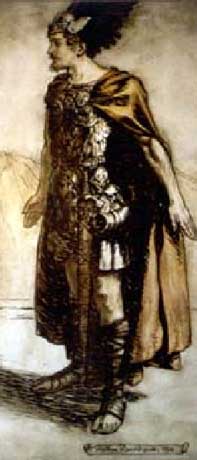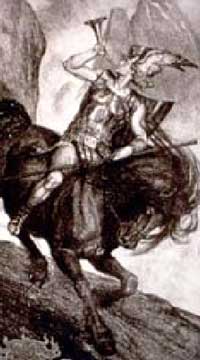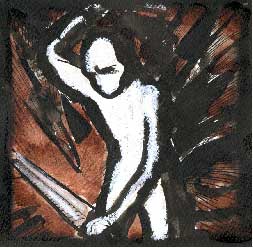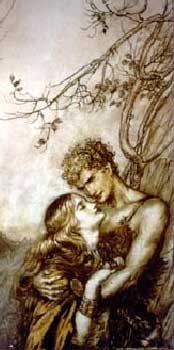![]()

![]()
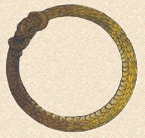

624 pages,
446 illustrations


|
•
|
|
|
•
|
|
|
•
|
|
|
•
|
Who's Who |
|
•
|
Das Rheingold |
|
•
|
Die Walküre |
|
•
|
Siegfried |
|
•
|
Die Götterdämmerung |
|
•
|
|
Der Ring des Nibelungen
Patrice Chereau - Pierre Boulez, Bayreuth Festival (Complete Ring Cycle)

|
opera online sitemap |
||
Wagner sees in Erda a woman covered with hoarfrost, buried to the waist. She is a figure of nightmare, a spectre of eternal dismay. Like her daughters the Norns, she appears in the storm and the darkness. As if numbed, lost in an indecisive dream, she is essentially negative. Like Loge and the Rhine maidens, she represents the nature prior to the Lance, the Nature in its original state. Wotan, who enslaved Loge, seized the Gold, paid Walhalla and soiled the Source, attacks Erda and forces her to bear him a daughter. Erda is a typical figure: the Sybille, the sacred clairvoyant. Chéreau represents her as a Kabyl fortune-teller, clad as a moving clod of mud. The
Characters of the "Walküre"
It will be necessary that Sieglinde explain their gemellarity to him, so that he understands it. Siegmund like Siegfried love freedom and reject the laws. Alive in the present moment, he is incapable of establishing the slightest link of cause and effect. He merely notices that his values are opposite to those of society, without trying neither to adapt himself to them nor to wonder about their validity. He is an epic character by his long story of pursuing. He likes story telling.
He is well placed to know the fate reserved for him; the girl he defended was killed. We can imagine the punishment reserved by the servants of Fricka - Neidingen for incest and adultery! It is the most plausible version.
A third characteristic of Siegmund is his unmistakable humanity. For the first time in the Ring, appears a being inspired by Freia. Siegmund is sensitive to the beauty of Nature (the song of the Spring) and the beauty of a woman. This feeling inspires him one of the rare poetic passages of all the tetralogy. He gives a wholesome lesson to the Walkyrie, which is surprised to see to prefer a poor sick woman to the bliss of Wotan's wishmaidens. For the first time also, appears love, tenderness, and the feelings of Siegmund are contagious. They are passed on to the Walkyrie, who, upset, will find the stamina to oppose to the Iron Law of Power. Finally, Siegmund is brave. Not in the style of the young unconscious who plays his life at the roulette because he believes he is immortal. But as any conscious being who knows suffering and fear, and who being true to himself carries the burden of life, which he hates. This courage takes several forms: heroic when he tears away Nothung from its sheath and when he faces Hunding in fight, quiet and noble when he resists the Walkyrie and accepts death.
The one that describes the fate of wolves, the Wälsungen, consists of three successive sections: a sort of heroic and funeral march, which accelerated turns into aggressive fanfare, this march is followed by a plaintive theme evoking an unfortunate fate, finally a third very sweet and almost comforting, major section resulting in a desperate conclusion.But when Siegmund evokes women in one way or another, the vocal line takes on extreme inflections of sweetness and longing joined to a delicacy of nuances which contrasts strongly with the heroic and aggressive breaks of the stories. What else can one add?
Freia's theme is represented only by its second section said often " flight motive " and serving as onset in the theme of love. The other theme associated to Sieglinde: a Dionysian fanfare expressing a revolt and a sexual desire repressed for a long time. Finally a ceaselessly repeated sinuous motive accompanies the touch of the body of her bridegroom brother: it expresses seduction, but also a sort of plaintive and obsessional desire.
It is she who recognizes her brother, but she will tell him the truth only when the point of no return is crossed. Like Erda and Brünnhilde, Sieglinde is clairvoyant. She sees her brother torn by the pack. Same as for Siegmund, her existence is placed entirely under the sign of the misfortune, and same again as for him it is the poignant will to fight, to strive towards happiness.
In my opinion, aversion and illness do not result from incest. After all, the healthier relationship between Brünnhilde and Siegfried is not less incestuous. The mental and emotional consanguinity is really what shocks more than the physical consanguinity (the same voice, the same glance). During the duet of love, very strange if one thinks of it, each one of them recognizes his reflection in the other. The love relation is almost narcissistic and is placed under the sign of blood. The last words of the duet of love are "Wälsungen-Blut ". On this word Blood, the theme of the misfortune falls like an axe.
For Jung, the couples thought - feeling and sensation - intuition are mutually exclusive. Fricka, however, is radically rational and logical thought and sensation (she is pretty and lives in the present: she believes only what she touches). Brünnhilde on the contrary is feeling and intuition: she perceives only the past and the future, for which Siegfried blames her. She describes herself as "barely intelligent ", which is of course false, because she has the most important intelligence, that of the heart. Brünnhilde is the only person to release herself from the control of the God; the latter will not forgive her for that. When she wakes up two contradictory feelings tear her: the fear of rape and decay, an exacerbated sensuality that has been repressed for such a long time. If in Alberich's case denied love and sexual frustration are transformed into paranoiac ecstasy of the ego, in Brünnhilde's case she undergoes an inverse transformation by awakening.
By waking up she acquired both Jungian functions, which she was missing: the capacity of reasoning, sensuality. Paradoxically, it is Siegfried who is going to be in a position of inferiority: living only in the present, and incapable to understand the slightest allusion in the words of his mistress, whom he initially mistakes for his mother. A psychological error committed by Brünnhilde is not to understand that love should be compensated by an equal exchange, and that the risk that one loves more than the other condemns to sufferance.
But as soon as she learns about his depression she has a feeling that he will ask for help, she becomes cold, distant, condescending and vaguely contemptuous. When she holds between her hands the fate of the world, and the fate of this father whom just a moment ago she claimed to love, not only she refuses to abandon this Ring, which is only an allegory, but also she shamelessly chases away the unfortunate Waltraute. The severity of Brünnhilde, one understands, even without evoking the curse, gives evidence of transformation of the Ring into fatal talisman. Very soon she will provoke Siegfried by brandishing the Ring, a suicidal gesture. After the obnoxious scene of the fight with the false Gunther, the neurotic characteristics of the ex-Walkyrie reach a paroxysm. More than ever, she will complain, setting the radiant force of cruelty of Siegfried against the weakness of the poor woman. But this frustration and the apathy consecutive to the brutality of her husband are going to be reversed and transformed into jealousy, and into desire to murder. Irrational and impulsive desire
I may remind you that in Act II of "Walküre", the original stage setting by Wagner foresaw three topological levels. Top floor (heaven): the Gods are in the sky and at the top of cliffs. Middle floor: a rocky platform suspended between heaven and earth. Brünnhilde addresses Siegmund without ever touching him. Third floor: Sieglinde and Siegmund on earth of the humans. Brünnhilde establishes the connection between the poignant bittersweet adventure of the twins, harbour of tenderness and love in the aridity of the Ring, and the vast concerns of the Gods. The Walkyrie Brünnhilde is doubtless the key figure, the pivot of the Ring, the perfect intermediary.
In popular mind, the Walkyries are the symbol of the Ring, Wagner is the grandfather of triumphant German militarism and Siegfried is the Aryan hero praised and sung by the Nazis.They are musical monuments amounted to the glory of the imperious and triumphant German race. Deutschland über Alles. But the reality written in the opera partition is absolutely different and the Ring of Centenary was necessary to show it. The eight sisters are real hyenas, characters accumulating the negative connotations. Deprived of adequate selves, they are terrorized by Walvater Wotan who despises them openly; they are incapable to help the two women on the run. They restrict themselves to a corporatist reflex of defence towards Brünnhilde. Their necrophilia role deserves a phantasmagoria of horror. Their built in function is to instigate the frenzy, the virility of young people to make them to death. Hegel asserted, not without reason, that the one that wins in the fight is the hero who pawns his life to defend his cause. Walkyries suite this definition to the extreme: the heroes whom they select entail and coach for Walhalla (the Hall of the heroes), correspond all to the definition of Hegel: yes they are fearless winners, but they are dead.
She depicts the troop of her sisters in a horrible light. The warrior sisters incapable of any reaction, surround wallowed on the ground, terrorized, and paralysed by fear, the indifferent and depressive God. They are unemployed and demoralized by idleness. The Walkyries will perish in the final fire with the powerless and catatonic gods. The
Characters of " Siegfried "
He will really know himself only when he dies. Many a stage director has interpreted the transformation of Siegfried after his first sexual experience by growing him a beard overnight! Such approach was at the origin of many popular misunderstandings, which affected the Ring and threw a doubtful light on its "ideology". On the first images of Doepler or Echter, Siegfried is an anti-authority ecologist, a good young man in the pink cheeks and a sweet glance. Rackham makes a moving portrait of his innocence and sweetness. It is only after the First World War that Stassen makes him a symbol of the Teutonic fighting spirit. Braune and the other Nazi iconographers will stress this aggressive side. The affectionate protester, in love with freedom, close to nature and dreaming about the friendship of a companion, becomes the beautiful animal, powerful and aggressive, dreamed and sung by Nazi iconographers.
So, one could see Siegfried as a dull beer barrel, in Bavarian pair of shorts and beer drinker's paunch or as protonazi officer super-evolving among swastikas and mussolinien monuments. I wondered for some decades what Wagner would have done if he had had to represent his favorite hero with modern means. Let us enumerate some features of the character, revealed by the image of Wagner and those that worked with him have seen it. First of all, Siegfried is as cheerful, as his father is sad. Even, if following the example of the Rhine maidens, his laughter is cruel. At the beginning, having imposed a wholesome fear to the dwarf, he is obliged to sit down to calm his laughter.
Sometimes Siegfried is represented as a quiet muscled imbecile. But the false duet of love with Brünnhilde shows him in a surprisingly different way. The boy shows himself as a skilful courtier and answers the arguments of the Walkyrie with remarkable logic and sharpness. Mime hates Siegfried, Wotan is proud of him at the beginning, but is cruelly humiliated by his presumed heir. Brünnhilde feels for him an unfathomable, unspeakable, maternal tenderness, alternating with a wild idolization which paves the way for prepares for a wild vengeance. The key passages that stir up Brünnhilde's feelings for Siegfried are the following:
The same theme comes up when the magic caress make the hero invulnerable. (Apparently, his back was not caressed!) 2. " Ewig war ich... " Brünnhilde begs Siegfried not to infringe on her virginity and to keep her as his anima. Two motives accompany these psychoanalytical verses before the word. The first one, said "about peace" results from a string quartet, but its line of bass reproduces the motive of Walkyrie's slumber.
This obsessing and discreet theme appears laconically and only four times in the Ring. When Brünnhilde asks her lover not to overwhelm her but to spare her, when in solitude, in the middle of the near thunderstorm, she contemplates the wedding Ring and later when ill treated by Siegfried she falls broken into his arms and meets her shining glance, finally when she is mad with resentment she evokes this fatal moment. These themes reflect the character of a very young man, almost a child. And this teenager is capable of arousing feelings of an unfathomable protective tenderness, of a melancholic and worried care, of a boundless admiration. Such character does not agree with the reputation of an insensible brute, which is generally attributed to Siegfried.
The above enumerated brings a precious light on the character of the young man: Wagner liked him and admired him. The composer identified himself with Brünnhilde as he identified Siegfried with his son. This is the source of his ambiguous longing for the inaccessible, which is typical for the homosexual phantasm. We know that Siegfried Wagner, who was unhappily named after the hero of the Ring, died of a heart attack after having directed the funeral march of Siegfried. |
||||||||||||||||||||||||||||||||||||||||||||||
|
|
||||||||||||||||||||||||||||||||||||||||||||||

